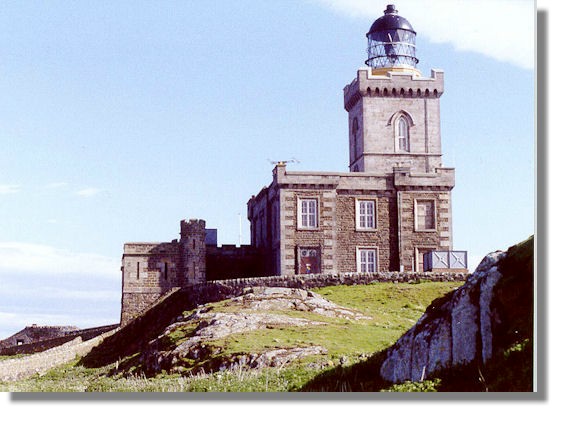

Lighthouse Beacons from Scotland
Isle of May Lighthouse

Photo via Wikimedia
The Isle of May is located to the north of the outer Firth of Forth, approximately 8 km (5.0 mi) off the coast of mainland Scotland. It is 1.8 km long and less than half a kilometre wide. The island is owned and managed by Scottish Natural Heritage as a National Nature Reserve.
Most visitors to the island take the ferry from Anstruther in Fife, although up to six visitors can stay at the observatory, usually for a week at a time. The island is closed to visitors from 1 October until 1 May to prevent disturbance to the large number of seal pups born there. The Scottish Seabird Centre at North Berwick has three live cameras on the island, which can be remotely controlled by visitors at the Seabird Centre, to allow close viewing of the seabird cities in spring and summer and the fluffy Grey seal pups in winter, without disturbing the animals. There are now no permanent residents, but the island was the site of a priory (St. Adrian's Priory) during the Middle Ages.
A coal-fired beacon was established in 1635 (or 1636) by James Maxwell and John and Alexander Cunningham, who charged shipping a tonnage-based fee. Initially, the charge for Scottish ships was half that for non-local shipping per voyage. The beacon, the first permanently manned one in Scotland, was considered at the time to be one of the best in existence but used around 400 tons of coal per year, requiring three men to look after it. (The picture here of the early lighthouse building is by John McMillan, via Wikimedia)
The Northern Lighthouse Board purchased the island in 1814 from the Duke and Duchess of Portland by which time the beacon was the last remaining private lighthouse in Scotland. A "modern" lighthouse was built on the island in 1816 by Robert Stevenson (see illustration at top of this page). Its ornate gothic tower on a castellated stone building was designed to resemble a castle, 24 metres (79 ft) high and with accommodation for three light keepers and their families, along with additional space for visiting officials. The new lighthouse started operating on 1 September 1816, and is now a listed building.
It was upgraded in September 1836, when a new light and refractor lens was fitted, and further extensive work took place in 1885–1886. Additional dwellings, boiler and engine houses, a workshop and a coal store were built 250 metres (270 yd) from the lighthouse in a small valley containing a fresh water loch. A new light was first used on 1 December 1886 and produced four flashes every 30 seconds. The high cost of the coal, around 150 tons per year, along with improvements in oil lights led to it being replaced with an incandescent mantle in 1924. (The graphic here is bySteve Johnston, via Wikimedia).
Another smaller lighthouse, the Low Light was constructed a few hundred yards from the main light in 1843 to provide (with the main lighthouse) a pair of lights which would become aligned to help ships avoid the North Carr Rock 11 kilometres (6.8 mi) to the north of the island off Fife Ness. It was first used in April 1844, but is no longer operating, having been made redundant by the establishment of the North Carr Lightship in 1887 and the building is now used for bird watching.
The lighthouse became a "rock" station in August 1972, meaning that the keeper's families were no longer accommodated at the lighthouse but on the mainland, and a fully automatic one installed in March 1989 shortly before ownership of the island passed to the Nature Conservancy Council. It is now monitored and controlled via a UHF radio link to Fife Ness Lighthouse and then by landline to the Northern Lighthouse Board headquarters in Edinburgh. The modern light produces two white flashes every 15 seconds, and has a range of 41 kilometres (22 nmi) in good visibility. There are two fog signals from buildings at each end of the island. The North and South horns did not blast together, being approximately 67.1/2 seconds apart. This facility was discontinued in 1989.
Return to Index of Lighthouse Beacons from Scotland



